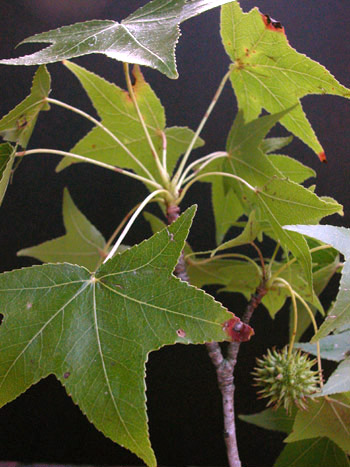Contents:
Common Names | Parts Usually Used | Plant(s) & Culture | Where Found | Medicinal Properties
Legends, Myths and Stories | Uses | Formulas or Dosages | How Sold | Bibliography
Scientific Names

- Liquidambar styraciflua L.
- Hamamelidaceae
- Witch-hazel family
Common Names
- Copalm
- Gum tree
- Liquidamber
- Liquid storax
- Opossum tree
- Red gum
- Star-leaved gum
- Styrax
- White gum
Parts Usually Used
Balsam, bark
Back to Top
Description of Plant(s) and Culture
Sweet gum is a deciduous, forest-dwelling tree, growing as high as 150 feet, the tree is covered with rough, gray bark; but the branchlets are reddish-brown and often have corky ridges. When cut, it exudes a sticky, resinous gum or balsam. Its alternate, serrate, palmately lobed (star-shaped with 5-7 toothed lobes) leaves are dark green and shiny above and pale green underneath; in fall they turn a deep crimson. Leaves have an aromatic pine-like scent when crushed. The petalless flowers occur in globular heads, the male heads clustered in terminal racemes and the female growing individually on long peduncles. The fruit consists of woody capsules growing in round, spiny heads an inch or more across which stay on the tree through the winter. They are spiky brown hanging balls.
Back to Top
Where Found
Native to the eastern and southern areas of the United States. Found in mixed woods, in moist soils of streams and riverbanks; planted in cities in the east, in the Pacific states, British Columbia, Central America, Mexico. Native from southern Connecticut south to Florida and west to Texas.
Back to Top
Medicinal Properties
Antiseptic, astringent, expectorant
Back to Top
Legends, Myths and Stories
The “gum” is produced in pockets in the bark.
Children sometimes chew the gum in lieu of commercial chewing gum.
Back to Top
Uses
The balsam is used effectively externally for wounds and for skin problems. For external use it is usually made into an ointment with lard or oil. Native Americans used a decoction of leaves or roots as a wash to treat injuries. For coughs and respiratory congestion due to colds, the gum can be taken for expectoration or for sore throat. The bark has been used to relieve diarrhea and dysentery. Used to treat ringworm.
Back to Top
Formulas or Dosages
Decoction: boil 1 tsp. bark or balsam in 1 cup water. Take 1 cup a day, a mouthful at a time.
Tincture: a dose is from 1/4 to 1/2 tsp.
Back to Top
How Sold
Ingredient in “compound tincture of benzoin” available at pharmacies.
Back to Top
Bibliography
![]() The Herb Book
The Herb Book, by John Lust, Bantam Books, 666 Fifth Avenue, New York, NY. copyright 1974.
![]() Eastern/Central Medicinal Plants
Eastern/Central Medicinal Plants, by Steven Foster and James A. Duke., Houghton Mifflin Company, 215 Park Avenue South, New York, NY 10000
![]() Indian Herbalogy of North America
Indian Herbalogy of North America, by Alma R. Hutchens, Shambala Publications, Inc., Horticultural Hall, 300 Massachusetts Avenue, Boston, Massachusetts 02115, 1973
![]() American Folk Medicine
American Folk Medicine, by Clarence Meyer, Meyerbooks, publisher, PO Box 427, Glenwood, Illinois 60425, 1973
![]() Prescription for Nutritional Healing, Fifth Edition: A Practical A-to-Z Reference to Drug-Free Remedies Using Vitamins, Minerals, Herbs & Food Supplements
Prescription for Nutritional Healing, Fifth Edition: A Practical A-to-Z Reference to Drug-Free Remedies Using Vitamins, Minerals, Herbs & Food Supplements, by James F. Balch, M.D. and Phyllis A. Balch, C.N.C., Avery Publishing Group, Inc., Garden City Park, NY
![]() Webster’s New World Dictionary
Webster’s New World Dictionary, Third College Edition, Victoria Neufeldt, Editor in Chief, New World Dictionaries: A Division of Simon & Schuster, Inc., 15 Columbus Circle, New York, NY 10023
 An Instant Guide to Medicinal Plants
An Instant Guide to Medicinal Plants, by Pamela Forey and Ruth Lindsay, Crescent Books (January 27, 1992).
 The Rodale Herb Book: How to Use, Grow, and Buy Nature’s Miracle Plants (An Organic gardening and farming book)
The Rodale Herb Book: How to Use, Grow, and Buy Nature’s Miracle Plants (An Organic gardening and farming book), edited by William H. Hylton, Rodale Press, Inc. Emmaus, PA, 18049., 1974
